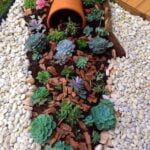Are you looking to start your own vegetable garden but not sure where to begin? In this article, we will explore the best ideas for vegetable gardening, providing you with tips and recommendations to kickstart your journey towards a bountiful harvest. Whether you’re a beginner or an experienced gardener, there’s always something new to learn when it comes to cultivating your own fresh produce right in your backyard.
Vegetable gardening is not only a rewarding hobby but also a great way to ensure a supply of fresh and healthy food for you and your family. By selecting the right vegetables for your garden and carefully planning the layout, you can maximize space and sunlight to promote optimal growth. From tomatoes and cucumbers to carrots and peppers, the possibilities are endless when it comes to choosing what to plant.
To set the foundation for healthy plants, soil preparation and fertilization are essential steps in vegetable gardening. By understanding the specific needs of each type of vegetable, you can create an environment that encourages strong root development and abundant yields.
Equipping yourself with the right tools and equipment will also make tasks such as planting, weeding, and harvesting much easier and more efficient. Let’s dive into the basics of vegetable gardening so you can get started on creating your own thriving garden oasis.
Selecting the Best Vegetables for Your Garden
When it comes to vegetable gardening, selecting the best vegetables for your garden is crucial to ensure a successful harvest. By choosing the right veggies to plant, you can maximize your garden’s productivity and enjoy a bountiful supply of fresh produce throughout the season. Here are some tips and recommendations to help you make the best choices for your vegetable garden.
Consider Your Growing Conditions
Before selecting which vegetables to plant in your garden, it’s important to consider your growing conditions. Take into account factors such as the amount of sunlight your garden receives, the quality of your soil, and the climate in your area. Some vegetables thrive in full sun, while others prefer partial shade. Make sure to choose veggies that are well-suited to your specific growing conditions for optimal growth and yield.
Choose Vegetables You Enjoy Eating
While it may be tempting to plant a wide variety of vegetables in your garden, it’s essential to focus on growing veggies that you actually enjoy eating. Consider what you and your family like to eat and prioritize those options when selecting crops for your garden. This way, you’ll be more motivated to tend to your plants and harvest the fruits of your labor when they’re ready.
Opt for Easy-to-Grow Varieties
If you’re new to vegetable gardening or have limited experience, it’s a good idea to start with easy-to-grow varieties that are low-maintenance and forgiving for beginners. Vegetables like tomatoes, zucchini, lettuce, and radishes are excellent options for novice gardeners as they are relatively easy to grow and produce satisfying results with minimal effort. Once you gain more experience and confidence in gardening, you can always expand your repertoire with more challenging crops.
By following these tips and recommendations when selecting vegetables for your garden, you’ll set yourself up for a successful growing season filled with an abundant harvest of delicious homegrown produce. Remember that experimentation is key when it comes to finding out which veggies thrive best in your garden, so don’t be afraid to try new varieties each year. Happy gardening.
Planning Your Vegetable Garden Layout
When it comes to planning your vegetable garden layout, maximizing space and sunlight are key factors to consider for a successful harvest. The first step in designing your vegetable garden is to assess the available space you have.
Whether you have a small backyard or a larger plot of land, making the most out of the area you have is crucial. Consider factors such as accessibility, sunlight exposure, and the proximity to water sources when deciding where to place your garden beds.
One popular technique for maximizing space in a vegetable garden is square foot gardening. This method involves dividing your garden into square foot sections and planting different vegetables in each square. Not only does this help optimize space, but it also allows for better organization and easier maintenance. Additionally, companion planting can be a great way to maximize space while also benefiting the overall health of your plants. Pairing compatible vegetables together can help deter pests and improve pollination.
In addition to maximizing space, ensuring that your vegetables receive adequate sunlight is essential for their growth and productivity. Most vegetables thrive in full sun, which typically means they need at least 6-8 hours of direct sunlight each day.
When planning your vegetable garden layout, take note of any potential obstructions such as buildings or trees that may block sunlight to certain areas. By strategically positioning your garden beds to receive maximum sunlight exposure, you’ll provide your plants with the energy they need to flourish and produce bountiful harvests.
Soil Preparation and Fertilization
In addition to enriching the soil with organic matter, gardeners should also consider using natural fertilizers to provide plants with essential nutrients throughout the growing season. Organic fertilizers like fish emulsion, seaweed extract, or bone meal can supply nitrogen, phosphorus, potassium, and other micronutrients that promote strong root development, healthy foliage growth, and high yields.
By incorporating these natural supplements into the soil before planting and as needed during the growing period, gardeners can support their vegetables’ overall health and productivity.
Maintaining proper soil fertility is an ongoing process in vegetable gardening, as crops deplete nutrients over time through their growth and fruit production. Regularly amending the soil with compost or well-balanced organic fertilizers ensures that plants have access to vital nutrients for continuous growth and optimal yields. By focusing on soil preparation and fertilization as foundational elements of vegetable gardening, growers can set themselves up for success in cultivating a thriving garden full of nutritious homegrown produce.
| Aspect | Importance |
|---|---|
| Soil Preparation | Essential for providing necessary nutrients to plants. |
| Fertilization | Important in ensuring continuous supply of nutrients for plant growth. |
Essential Tools and Equipment for Successful Vegetable Gardening
Vegetable gardening requires the use of essential tools and equipment to ensure successful cultivation and maintenance of your plants. One of the most important tools for any gardener is a high-quality set of hand trowels, pruners, and shears. These tools will help you plant, prune, and harvest your vegetables with ease. Additionally, a sturdy garden hoe and rake are essential for preparing the soil and keeping your garden tidy.
Another key piece of equipment for vegetable gardening is a watering system that meets the needs of your plants. Whether you opt for a traditional watering can, a drip irrigation system, or a soaker hose, it is crucial to keep your vegetables properly hydrated throughout the growing season. Additionally, having a reliable wheelbarrow or garden cart will make it easier to transport soil, compost, mulch, and harvested produce around your garden.
To protect yourself while gardening and handle tasks efficiently, don’t forget to invest in quality gloves, knee pads, and a wide-brimmed hat to shield yourself from the sun. Gardening can be physically demanding, so having ergonomic tools such as padded kneelers or cushioned grips can help reduce strain on your body during long hours spent working in the garden.
By equipping yourself with the right tools and gear, you’ll be well-prepared to tackle any task that comes your way in your vegetable garden.
| Tools & Equipment | Importance |
|---|---|
| Hand trowels, pruners | For planting and pruning veggies |
| A sturdy hoe & rake | Prepares soil and keeps garden neat |
| Watering system (irrigation or can) | To keep plants hydrated |
| Gloves & protective gear | For safety & comfort while gardening |
Managing Pests and Diseases Organically
Identifying Common Pests and Diseases
One of the biggest challenges that vegetable gardeners face is managing pests and diseases that can wreak havoc on their plants. Some common pests to watch out for include aphids, caterpillars, slugs, and beetles, while diseases like powdery mildew, leaf spot, and blight can also affect your vegetable crops. By being able to identify these issues early on, you can take the necessary steps to protect your garden.
Natural Pest Control Methods
When it comes to managing pests in your vegetable garden, there are several natural methods you can employ. One effective strategy is companion planting, where certain plants are grown together to deter pests. For example, planting marigolds alongside tomatoes can help repel nematodes. Additionally, introducing beneficial insects like ladybugs and lacewings can help control pest populations without the use of harmful chemicals.
Preventative Measures and Disease Management
In addition to dealing with pests, it’s crucial to implement preventative measures to minimize the risk of diseases affecting your vegetable plants. Proper crop rotation and spacing between plants can help prevent the spread of diseases. Using disease-resistant varieties of vegetables can also be a good strategy for keeping your garden healthy. If disease does occur in your garden, consider using organic fungicides or bactericides to manage the issue without harming beneficial insects or the environment.
By implementing these organic pest and disease management strategies in your vegetable garden, you can protect your plants naturally while promoting a healthy and thriving growing environment. Remember that prevention is key when it comes to maintaining a successful garden full of delicious homegrown vegetables.
Watering and Mulching Techniques
Proper watering and mulching techniques are essential components of successful vegetable gardening. Maintaining the right moisture levels in your garden is crucial for the health and growth of your plants. Here are some tips and ideas to ensure that your vegetables thrive:
- Watering: One of the best practices for watering your vegetable garden is to water deeply but infrequently. This encourages deep root growth and helps plants become more drought-resistant. It’s important to water at the base of the plants, rather than overhead, to prevent diseases. Consider investing in a soaker hose or drip irrigation system for efficient watering.
- Mulching: Mulch is a gardener’s best friend when it comes to retaining moisture, suppressing weeds, and maintaining soil temperature. Organic materials like compost, straw, or shredded leaves make excellent mulch options for vegetable gardens. Apply a layer of mulch around your plants, leaving space around the stems to prevent rotting.
- Smart Watering Schedule: To determine when to water your garden, perform a simple soil moisture test by sticking your finger into the soil. If it feels dry an inch below the surface, it’s time to water. Early morning is often the best time to water your garden as it allows foliage to dry before nightfall, reducing disease risks.
By following these watering and mulching techniques, you can maintain proper moisture levels in your vegetable garden, ensuring that your plants thrive throughout the growing season. Experiment with different methods and find what works best for your specific garden layout and climate. Remember that consistency is key when it comes to watering – providing a stable environment will help your vegetables grow strong and healthy.
Remember that proper watering and mulching techniques are just one part of creating a successful vegetable garden. Combine these practices with healthy soil preparation, regular pest management, and attentive care for a bountiful harvest. With dedication and patience, you can enjoy the satisfaction of growing your own nutritious vegetables right at home.
Incorporating watering and mulching techniques into your gardening routine will not only benefit your current crop but will also set the stage for future success in your vegetable garden endeavors. Embrace these fundamental practices as part of your gardening repertoire and watch as your vegetables flourish with vitality under your careful tending.Repository Name.
Harvesting and Storing Your Homegrown Vegetables
To ensure that you harvest your vegetables at the peak of freshness, it is essential to know when each crop is ready for picking. Different vegetables have different indicators of ripeness, such as color, size, and texture. Creating a harvest calendar or keeping a journal can help you keep track of when each vegetable should be harvested to prevent them from becoming overripe or past their prime.
Once you have harvested your vegetables, proper storage is key to maintaining their quality and freshness. Storing vegetables properly can extend their shelf life and minimize waste. Consider investing in storage containers like ventilated plastic bags, glass jars, or airtight containers to keep your produce fresh for longer periods.
Additionally, some vegetables are suitable for freezing or canning if you have a surplus that you’d like to preserve for later use. Here are some tips for storing common homegrown vegetables:
- Leafy greens (lettuce, spinach) – Store in a plastic bag with a paper towel to absorb excess moisture.
- Root vegetables (carrots, potatoes) – Store in a cool, dark place with high humidity.
- Tomatoes – Store at room temperature away from direct sunlight until fully ripe, then refrigerate if needed.
- Herbs – Wrap in a damp paper towel and store in an airtight container in the refrigerator.
By mastering the art of harvesting and storing your homegrown vegetables, you can savor the flavors of your garden all year round while reducing food waste. Enjoying fresh vegetables that you’ve grown yourself not only tastes better but also provides a sense of accomplishment and satisfaction. So roll up those sleeves, get out into the garden, and start reaping the benefits of all your hard work.
Conclusion
In conclusion, embarking on a vegetable gardening journey is not only rewarding but also beneficial in many ways. The satisfaction of harvesting your own fresh produce, free from harmful chemicals and pesticides, is truly unmatched.
Not to mention the joy of being able to enjoy delicious, homegrown vegetables that are packed with nutrients and flavor. By following the best ideas for vegetable gardening outlined in this article, you can create a thriving garden that will provide you with a bountiful harvest throughout the growing season.
Furthermore, cultivating a vegetable garden offers numerous health benefits as well. Engaging in gardening activities has been shown to reduce stress and anxiety levels, improve mood, and increase overall physical activity.
The act of tending to your garden can be a therapeutic and meditative experience, allowing you to connect with nature and reap the mental health benefits that come with it. In addition, consuming freshly picked vegetables from your own garden ensures that you are getting the highest nutritional value possible from your food.
So, whether you have limited space or are new to gardening, now is the perfect time to start your own vegetable garden. With careful planning, proper soil preparation, and dedication to organic practices for pest control and plant care, you can successfully grow a variety of vegetables right in your backyard or even on your balcony.
The satisfaction of seeing your efforts bloom into vibrant plants and abundant harvests is truly unmatched. So grab your tools, seeds, and enthusiasm – it’s time to get started on your vegetable gardening adventure today.
Frequently Asked Questions
What Is the Best Layout for a Vegetable Garden?
The best layout for a vegetable garden depends on various factors such as the size of the garden, sunlight exposure, soil quality, and personal preferences. One popular layout is the raised bed system, which helps with drainage and organization of different vegetables.
What Is the Most Suitable for Vegetable Gardening?
The most suitable method for vegetable gardening would be using organic and sustainable practices. This includes using compost for soil improvement, rotating crops to prevent diseases, and avoiding chemical pesticides or fertilizers that can harm the environment and health.
What Would Be the Best Vegetable to Grow?
The best vegetable to grow in a garden would depend on factors like climate, soil type, and personal preferences. However, some easy-to-grow options for beginners include tomatoes, lettuce, peppers, zucchini, and herbs like basil or chives. It’s important to choose vegetables that are well-suited to your specific growing conditions.

Welcome to my gardening blog! I am passionate about plants and enjoy sharing my knowledge and experiences with others. In this blog, I will write about everything related to gardening, from tips on how to get started to updates on my own garden projects.





